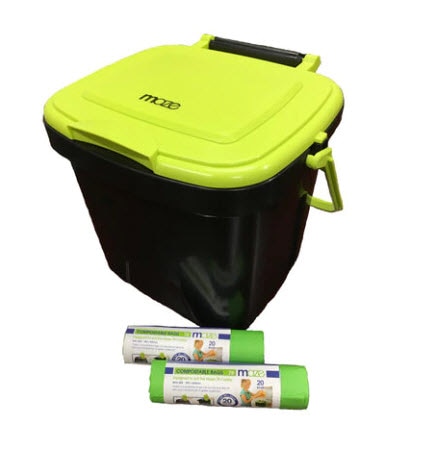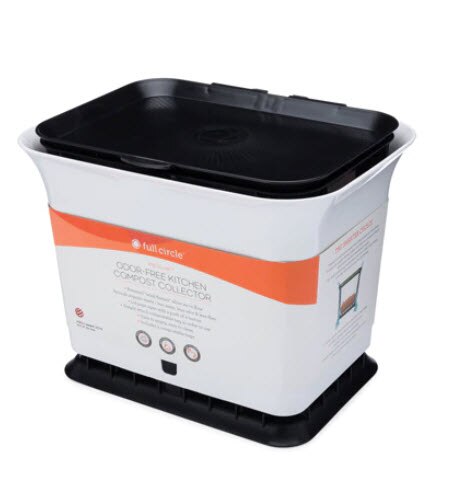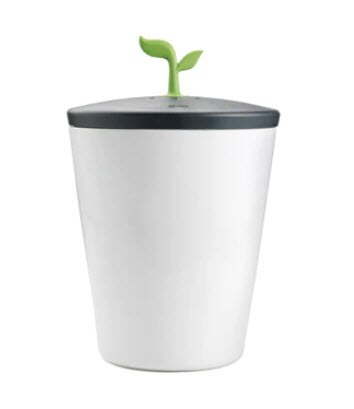Are you one of the eco-conscious people trying to cut the amount of waste you produce? If you’ve wanted to compost your food scraps but live in an apartment or somewhere you can’t have an outdoor compost bin, you’ll be thrilled to know there are more options than ever for composting indoors.
Whether you choose to subscribe to a composting service or get an indoor composting system, you can stop sending your waste to the landfill and start making something useful out of it instead.
Why compost?
Food waste is a huge problem in the United States, and it’s compounded by the fact that the vast majority winds up in our over-full landfills. In the anaerobic conditions of a landfill, the 75 million tons of compostable trash Americans send there each year produce methane, a greenhouse gas 25 times more potent than carbon dioxide.
When we keep food waste out of the landfill and turn it into garden gold instead, we’ve solved two problems at once. Less waste in the landfill, and loads of nutrient-rich soil amendments for gardens that don’t need carbon-intensive fertilizer.
Composting Without a Yard: 4 Methods
No yard for a compost bin? No problem! Try one of these ways you can compost your food scraps even if you live in a high-rise apartment building.
Subscription service
One simple way more people are choosing to compost is by subscribing to a weekly pickup service. Just like trash collection, a composting service comes to your residence and empties your collected food scraps. Then they turn all those eggshells and potato peelings into natural fertilizer for gardens.
If you don’t have a subscription service available, an app called “Sharewaste” can help you find people nearby who want to use your food scraps to make compost for their gardens or feed their chickens.
If you’d rather do the composting yourself, you have several options, discussed below.
Note that you will need to figure out what to do with the finished compost your produce. Unless you keep a lot of houseplants or grow food on your balcony or windowsill, you’ll need to find someone who can use the compost you’ll be making out of your food scraps.
Countertop food recycler or electric composter
An easy option for indoor composting is an electric food recycler, which grinds and dries food into a powder that can be added to soil. Not technically compost, the finished product isn’t a moist soil-like substance teeming with microbes, but a sterile powder. While the makers of these machines refer to it as fertilizer, because the machine has dried, but not composted the food scraps, it’s not clear the nutrients would be available to plants until the material has a chance to break down as organic matter does in compost.
However, for apartment-dwellers, the dry, odorless nature of the finished product may make it easier to store and share with others.
Before buying something labeled as an electric composter, read how it works carefully. Most of these machines merely dry and grind food, while others use microorganisms to actually make compost.
One big upside of these machines is that they take care of your food scraps in a matter of hours, whereas other composting options take weeks to months to convert food into compost. Many composting machines have filters to minimize odors.
On the other hand, they use electricity, though not a lot, and the grinding step can make a little noise. They also take up counter space and cost anywhere from $300 to nearly $1000.
Vermicomposting
A less expensive indoor composting option is a worm bin. Known as vermicomposting, worm bins usually live under the kitchen sink. Worms eat up your food scraps, junk mail, and coffee grounds and turn it into highly nutritious plant food.
Pre-made vermicomposters sell for $25 to $100, or you can make one yourself using a plan you can find for free online. You’ll also need to stock it with worms, usually red wigglers, which you can buy online or from a bait shop or home improvement store. The EPA has a helpful page on building and maintaining a worm bin here.
Compost Tumbler
If you have a balcony or a shared patio, you can get a compost tumbler, which quickly turns food scraps into soil. Open the hatch, toss in the scraps, give it a spin, and let the microbes work their magic. The insulated bins eliminate odors and won’t attract rodents the way open bins do.
Compost tumblers range in size and price, costing from about $100 to $400. You might be able to convince your condo association to share the cost, and you’ll help reduce your neighbors’ food waste headed to the landfill as well.
Whichever method you choose, congratulations on joining the growing numbers of people helping to solve the world’s garbage problem, one banana peel at a time.




